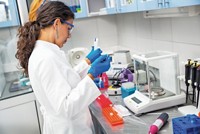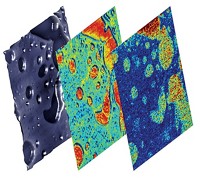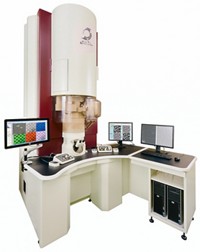Advertisement
Grab your lab coat. Let's get started
Welcome!
Welcome!
Create an account below to get 6 C&EN articles per month, receive newsletters and more - all free.
It seems this is your first time logging in online. Please enter the following information to continue.
As an ACS member you automatically get access to this site. All we need is few more details to create your reading experience.
Not you? Sign in with a different account.
Not you? Sign in with a different account.
ERROR 1
ERROR 1
ERROR 2
ERROR 2
ERROR 2
ERROR 2
ERROR 2
Password and Confirm password must match.
If you have an ACS member number, please enter it here so we can link this account to your membership. (optional)
ERROR 2
ACS values your privacy. By submitting your information, you are gaining access to C&EN and subscribing to our weekly newsletter. We use the information you provide to make your reading experience better, and we will never sell your data to third party members.
Analytical Chemistry
Enabling Nanoscale Spectroscopy
Start-up firm Anasys hopes to open new vistas in material and life sciences at the nanoscale level
by Marc S. Reisch
September 20, 2010
| A version of this story appeared in
Volume 88, Issue 38

Among the new scientific instruments that stood out at this spring’s Pittsburgh Conference on Analytical Chemistry & Applied Spectroscopy was the NanoIR. Combining infrared spectroscopy and atomic force microscopy, the instrument enables measurements of materials on the nanoscale level.
Anasys Instruments, the Santa Barbara, Calif.-based start-up firm that developed the NanoIR, expects it to open up new ways to look at polymers, analyze human cells, and reverse-engineer complex materials. And the small firm has big hopes. Roshan Shetty, chief executive officer, says the firm, which employs fewer than 20 people, hopes to capture a significant chunk of the $1 billion-per-year world market for IR spectroscopy instruments.
Traditional IR spectroscopy, a technique used to identify chemical compounds, has its limitations. “Because of optical diffraction limits, the typical spatial resolution of IR spectra using conventional absorption instruments has been several microns to tens of microns,” Shetty explains.
But Anasys’ approach is not optical, he says. It uses an atomic force microscope (AFM) probe’s resonant response to IR light pulses to measure IR spectra. The AFM not only makes possible spectral analysis of submicrometer samples but also measures the thermal and mechanical properties of a sample.
Curtis A. Marcott, a senior partner in the analytical chemistry consulting firm Light Light Solutions and a consultant to Anasys, calls the NanoIR, “a new set of eyeglasses. It allows you to see what you couldn’t see before.”
Anasys is also targeting the NanoIR at researchers who, for example, want to examine the multiple polymer layers in food packaging to reduce the thickness of adhesive tie layers. Current IR technology “can’t see the tie layer,” Shetty says.
The NanoIR could also help cancer researchers examine biopsy samples for more accurate and earlier diagnosis of mutagenic cells than is currently possible. And the high-resolution instrument, Shetty suggests, could enable researchers to reverse-engineer competitors’ products and better grasp their strengths and weaknesses.
Development of the NanoIR goes back to 2006 when Shetty got in touch with Alexandre Dazzi, a researcher at the University of Paris-Sud, in Orsay, France. Dazzi had adapted an AFM to perform a technique he called photothermal-induced resonance. Shetty licensed patents the university held on Dazzi’s technique and began work to develop the NanoIR.
Joining him in the effort to commercialize Dazzi’s patents and develop a salable instrument was Kevin Kjoller, Anasys’ head of product development. Cofounders of Anasys, the two men had worked together at Veeco Instruments, where Shetty was director of strategic investments and Kjoller led development of the firm’s scanning probe microscopes. The instrument they ultimately developed “is an optimized and more sensitive version of Dazzi’s home-built tool,” Shetty says.
Shetty and Kjoller started Anasys to commercialize a microscope-based thermal analysis tool they acquired from TA Instruments. They further adapted the tool at Anasys, developing an AFM-based nanoscale thermal analysis device called the NanoTA2.
However, what customers were really interested in, Shetty says, were AFM tools that could also perform chemical analyses. “AFM-tip-enhanced Raman spectroscopy instruments have been around for about 10 years, but they have not shown results on real-world samples,” he says.
Work with potential users such as Dow Chemical helped Anasys develop an IR absorption-based instrument “that solves problems with real samples,” Shetty says. The chemical firm supplied samples that allowed Anasys to refine the NanoIR’s capabilities.
Also crucial in commercializing the NanoIR were government grants. “The government funding was a defining moment,” Shetty acknowledges. The largest award was a $2 million grant from the National Institute of Standards & Technology. That was followed by over $750,000 in Small Business Innovation Research grants from the National Science Foundation.
“Anasys turned a lab experiment into a product,” says Rohit Bhargava, an assistant professor of bioengineering at the University of Illinois, Urbana-Champaign. Bhargava shared in the NIST grant and contributed to the development of the NanoIR.
“I’ve personally collected data with the NanoIR, and it seemed to work,” Bhargava says. But, he points out, “It is a first-generation instrument, and I can’t yet say if it is trouble free.”
Shetty acknowledges that the NanoIR is a new tool and will need continued R&D investments. “We are not working on any other instruments for now,” he says. The firm’s energy will go to growing what he hopes will be a “very large market” for the NanoIR in the next few years.





Join the conversation
Contact the reporter
Submit a Letter to the Editor for publication
Engage with us on Twitter